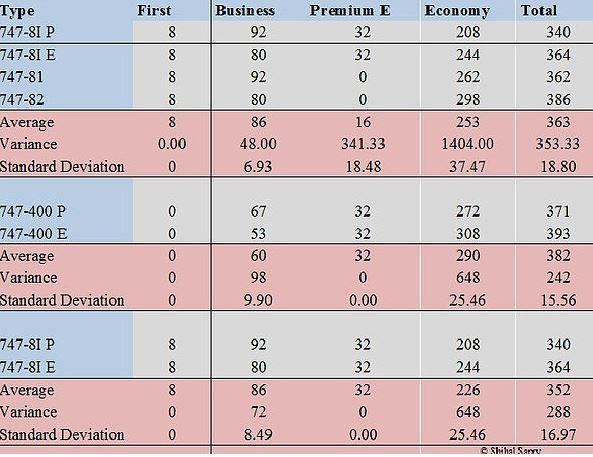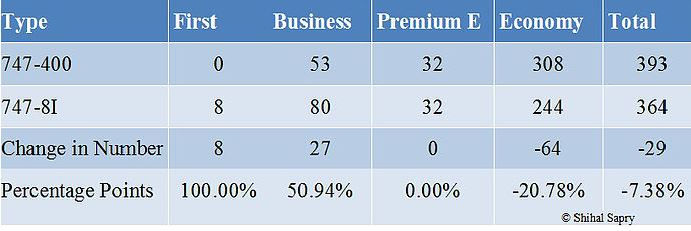Is there overcapacity at Lufthansa? Part B
- AviationCult

- Jan 14, 2018
- 7 min read
Updated: Feb 16, 2018
By Shihal Sapry
Continuing from Part A. Part B involves the 747-400 and 747-8I. Again, we STRONGLY recommend you to read this analysis on PC as it will take you at least 10 minutes to fathom our analysis.
Lufthansa operates 4 different 747-8I Layouts and 2 747-400 Layouts. We will only consider the 747-8I Layouts with a Premium Economy Cabin, as all the 747-400's have Premium Economy Cabins. As per Lufthansa's seat layouts, this aircraft size segment is from 340 to 400 seats depending on Premium/Non-Premium Layouts. Lufthansa does not operate any other aircraft in this size segment. We will compare the Premium 747-400 with a Premium 747-8I and vice versa. The diagrams below offer additional insight. Lufthansa flies the 747-400 and 747-8I to the same destinations with some being only 747-8I.

Over their 4 Layouts, Lufthansa seats on average 363 passengers in their 747-8I. The 747-400 average is 382. Of the two 747-8I layouts we will consider, the average seat count is 352. This indicates that the 747-8I is more Premium Dense. Lufthansa has more seats in their smaller 747-400's. Lufthansa does not have first Class on their 747-400's. All 747-8I's have an equal number of First Class Seats. The 747-8I1 is the Layout that Lufthansa first flew on this aircraft.
The Standard Deviations(SD) on the entire 747-8I fleet indicate:
1). There is not a material difference in the number of Business Class Seats
2). The large SD for Premium Economy is representative of 2 layouts not having Premium Economy Cabins.
3). The SD larger than that of Premium Economy is representative of the Economy Class Seat count ranging from 208 to 298 seats. This is indicative of the Premium and non-Premium Layouts Lufthansa operates.
Between the 747-400 fleet and the 747-8I fleet:
1). The 747-400's have 26 fewer Business Class Seats on average
2). The 747-400's have 16 additional Premium Economy Seats on average. This is twice as much as the 747-8I.
3). The 747-400's have 37 additional Economy Class Seats on average.
Between the 2 747-8I Layouts we consider and the entire 747-8I fleet, the average number of:
1). Business Class Seats are 1 seat lower on the rest of the fleet 2). Premium Economy Seats are 8.8 seats lower on the rest of the fleet. 3). Economy Class Seats are 25.2 seats high in the rest of the fleet. The differences between the Premium Economy and Economy is due to some 747-8I's not having a Premium Economy Cabin.
Between the 747-400 fleet and the 747-8I fleet(The 2 Layouts):
1). There are no First Class Seats on the 747-400's
2). The 747-400's have 26 fewer Business Class Seats on average 3). Both fleets have equal numbers of Premium Economy Seats.. 4). The 747-400's have 64 additional Economy Class Seats on average. 5). The SD between the 747-400 and 747-8I Business Class is less than 1.5%. This would indicate that these two layouts of each respective aircraft are similar to each other. 6). The SD for Premium Economy is zero indicating the similarity of the two layouts. 7). The SD for Economy Class is equal for both fleet types. Once again, this indicates the similarity of the two layouts.
We are able to conclude that the 2 747-8I Layouts and the 2 747-400 Layouts are similar for their aircraft size. Lufthansa reconfigured their 747-400's which involved eliminating First Class.
As a rough estimate if we compare the two Non-Premium Economy 747-8Is, to the two 747-400's, we will obtain one Premium and one Non-Premium aircraft Layout for both aircraft types. Now, we look at the capacity differences between each fleet type's Business Class and Economy Class. We can note that these capacities differences between the 747-400 fleet type and the 747-8I fleet type is approximately similar. Hence we can conclude that these layouts are also similar except for Premium Economy.
Now we will compare the Premium Dense 747-400 and 747-8I

Lufthansa removed First Class from their 747-400's in a cabin retrofit, which was performed after the first 747-8I's entered the fleet. However, 747-8I's were still being delivered. Furthermore, Lufthansa would plan on flying their 747-400's for some time, since they have invested in this retrofit. Lufthansa had First Class seats on Upper deck of their 747-400's.
The 747-8I has 37.31% additional Business Class Cabin capacity. This highlights the Premium Dense nature of the aircraft. The Premium Economy Cabin capacity is neutral which suggests that, the number of seats is optimal. There are 747-8I's with no Premium Economy Cabins. The 747-8I has 23.53% smaller Economy Class Cabin over the 747-400. There is a net decrease of 8.36% on the 747-8I primarily attributed to the smaller Economy Class Cabin on the 747-8I.
We note that the other 747-8I's also have a maximum of 32 Premium Economy Seats. This further indicates that the Premium Economy capacity is optimal in this aircraft size segment. The 747-400 is less premium dense than the 747-8I. We also note via a seat map, that Lufthansa has on the main deck, 7 a breast Business Class seating on their 747-400's, while their 747-8I's have a 6 a breast Business Class seating. It is not illogical to deduce that Lufthansa has tried to fit in, as many Business Class seats as possible on the 747-400. It follows that Lufthansa tried to fit in, as many Economy Class seats as possible on their 747-400's. Assuming that the two previous statements are indeed true, it follows that for this aircraft size segment, the Business Class capacity of the 747-8I is more optimal than the Business Class capacity of the 747-400. It will be interesting to note what layout the 747-8I's will have if/when they undergo a cabin retrofit.
Another viewpoint, is that the 747-400 potentially requires additional seats to make it more competitive in the fleet. By increasing the seat count, Cost per Seat Mile decreases and allows the airline to offer more competitive fares. The airline cannot simply add 20-30 Business Class Seats, so instead they increase the Economy Class Capacity relative to the 747-8I. On an elementary level, it would apply primarily to Economy Class passengers.
The 747-400 retrofit attempted to match the Business Class capacity of the 747-8I whilst minimising the number of Economy Class Seats being lost. The 747-8I has an optimal Premium Cabin capacity. With both aircraft types flying the same routes, it is difficult to comment on the Economy Class capacity of the 747-8I. With the 747-8I being larger than the 747-400, it is possible that the 747-8I would be able to fit the capacity of the current 747-400 layout. We cannot with absolute certainty conclude that the 747-8I's will replace the 747-400's. There is insufficient evidence to indicate that overcapacity exists in Premium Dense portion of this aircraft size segment(340 to 400 seats).
Moving onto the less Premium Dense 747-400 and 747-8I.

We discussed the removal of First Class in the Premium Dense part.
The 747-8I has a 50.94% larger Business Class Cabin. This is a substantial difference. In the entire 747-8I fleet, the minimum number of Business Class seats is 80. With all of Lufthansa's 747-8I's delivered, we will not see any changes until retrofits of the 747-8I's take place or when new orders take place. Premium Economy Cabin capacity is neutral which suggests that, the number of seats is optimal. There are 747-8I's with no Premium Economy Cabins. The 747-8I also has a 20.78% smaller Economy Class Cabin. There is a net capacity decrease of 7.38%. This decrease is smaller than the Premium Dense net decrease, due to the larger Economy Class Cabins.
Our comments regarding the Premium Economy Cabin(capacity is optimal) are the same as per the Premium Dense portion. The 747-400 is again less premium dense than the 747-8I. We discussed Lufthansa's Business Class Seating arrangements in the Premium Dense portion. By minimising the space taken up by Business Class, it is highly probably that Lufthansa has tried to fit in, as many Economy Class seats as possible on the 747-400. Assuming that this statements is true, it follows that for this aircraft size segment, the Economy Class capacity of the 747-8I is less optimal than the Economy Class Capacity of the 747-400. It will be interesting to note what layout the 747-8I's will have if/when they undergo a cabin retrofit.
Once again we note that the 747-400 potentially requires additional seats to make it more competitive in the fleet. We discussed this in the Premium Dense portion and will not discuss it further.
With both aircraft types flying the same routes, it is difficult to comment on the Business and Economy Class capacity of the 747-8I. We note that the 747-400 Economy Class capacity is more optimal. With the 747-8I being larger than the 747-400, it is possible that the 747-8I would be able to fit the capacity of the current 747-400 layout. We cannot with absolute certainty conclude that the 747-8I's will replace the 747-400's. There is insufficient evidence to indicate that overcapacity exists in Non-Premium Dense portion of this aircraft size segment(340 to 420 seats).
In conclusion to Part B, the 747-400's are denser aircraft in both layouts. This could be attributed to reducing the Cost per Seat Mile of the 747-400. This explains why the 747-400's have a denser Business Class Seating arrangement per row and why the Economy Class Cabin capacity is much larger. This does not mean that the 747-8I's have replaced the 747-400's. With both aircraft flying the same routes, it is logical that Lufthansa wants their 747-400 to be as close to their 747-8I in terms of cost and profit. This enables the aircraft to fly a larger number of routes. The 777-X aircraft is appropriately sized for this aircraft size segment. The 777-X will be discussed later in Part D.
We can only comment on the 747-400's being much denser than their 747-8I counterparts. We have discussed a potential explanation. Lufthansa's densest 747-8I has the capacity of the densest 747-400. One difference being, that the 747-8I has the larger Business Class Cabin. the other difference being that the 747-8I has First Class but lacks a Premium Economy Cabin. It follows that Lufthansa's 747-8I's cover the capacity variations of the two 747-400 layouts. This would allow Lufthansa to fly both aircraft types on the same routes. With the current fuel price and with older aircraft having lower ownership costs, it is completely logical as to why they fly their refurbished 747-400's, side by side with the newest 747-8I. Hence, by these statements, there is insufficient evidence to conclude that there overcapacity exits in this aircraft size segment(340 to 400).

This Graph has been added for the sake of completeness. "P" denotes the most Premium Layout with "L" being the least Premium Layout. The "747-8I1" was the first 747-8I Layout Lufthansa flew. In Part C, we will discuss the A380 Fleet.






Comments